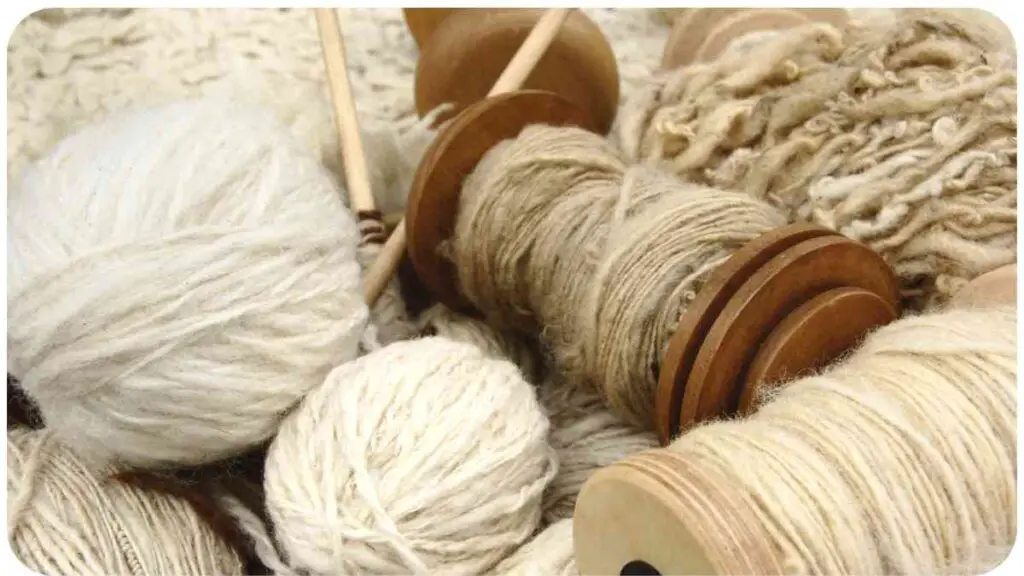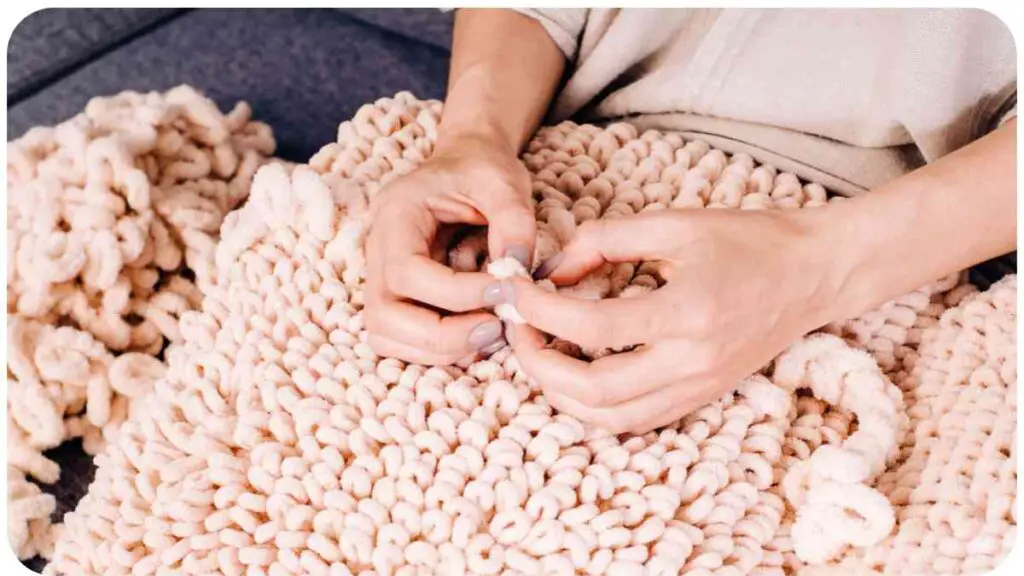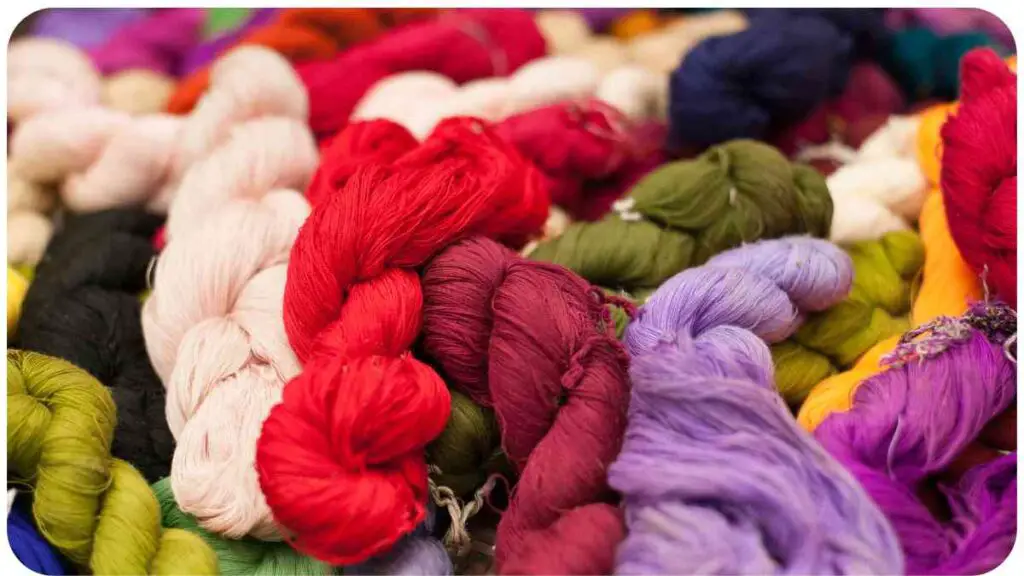Crocheting is a wonderful craft that allows you to create beautiful and unique projects using yarn. Choosing the right yarn for your crochet project is crucial as it can greatly impact the final outcome.
In this article, we will guide you through the process of selecting the perfect yarn for your crochet endeavors. We will cover important factors such as yarn fiber types, weight, color, texture, twist, and specialty yarns. Additionally, we will provide insights, tips, and personal anecdotes from our own experience to help you make informed decisions.
| Key Takeaways |
| Understand the importance of choosing the right yarn for crochet projects. |
| Acrylic yarns are excellent for beginners due to their affordability and ease of use. |
| Natural fibers like cotton and wool offer a range of textures and properties for different projects. |
| Variegated yarns can add visual interest and complexity to simple stitch patterns. |
| Avoid yarns with a lot of shedding or fuzziness, as they can make crocheting more challenging. |
| Experiment with different yarns to find your personal favorites and explore their unique characteristics. |
2. Understanding Yarn Fiber Types
The first step in choosing the right yarn for your crochet project is to understand the different fiber types available. Yarns can be categorized into natural fibers, synthetic fibers, and blend fibers.
“Understanding yarn weight is crucial for both knitting and crochet. When selecting your materials for a project, it’s essential to consider the yarn weight. This factor will greatly impact the final outcome of your crochet creation.”
Natural Fiber Yarns
Natural fiber yarns are made from materials that occur in nature. They are known for their breathability, softness, and comfortable feel. Some common natural fiber yarns include:
- Cotton: Ideal for warmer climates and summer projects due to its lightweight and moisture-absorbing properties.
- Wool: Provides excellent insulation and warmth, making it suitable for cold weather garments and cozy accessories.
- Alpaca: Known for its softness and hypoallergenic qualities, alpaca yarn is perfect for individuals with sensitive skin.
- Silk: Luxurious and lustrous, silk yarn adds an elegant touch to any project.
Synthetic Fiber Yarns
Synthetic fiber yarns are man-made materials that offer durability and affordability. They often have special properties and features that natural fibers may lack. Some popular synthetic fiber yarns include:
- Acrylic: Widely available and budget-friendly, acrylic yarn is easy to care for and comes in a vast array of colors.
- Nylon: Known for its strength and elasticity, nylon yarn is commonly used in projects that require durability, such as socks and bags.
- Polyester: Highly resistant to stretching and shrinking, polyester yarn is suitable for projects that need to retain their shape over time.
- Microfiber: Extremely soft and lightweight, microfiber yarn is great for creating delicate and comfortable garments.
“Planning your crochet project includes determining the right amount of yarn required. To avoid running out or having excess, explore the insights on yarn quantity. It will help you manage your supplies efficiently.”
Blend Fiber Yarns

Blend fiber yarns are created by combining different types of fibers to achieve desired characteristics. They often combine the best qualities of natural and synthetic fibers. Some examples include:
- Wool/Acrylic Blend: Provides the warmth and softness of wool with the affordability and easy care of acrylic.
- Cotton/Bamboo Blend: Offers the breathability and moisture-wicking abilities of cotton with the silky smoothness of bamboo.
Understanding yarn fiber types is essential in choosing the most suitable yarn for your crochet project. Each fiber has its own unique characteristics that will affect the drape, durability, and overall appearance of your finished item.
| Fiber Type | Properties | Best For |
| Cotton | Lightweight, breathable, moisture-absorbing | Garments, summer |
| Wool | Insulating, warm | Cold weather |
| Alpaca | Soft, hypoallergenic | Sensitive skin |
| Silk | Luxurious, lustrous | Elegant projects |
| Acrylic | Budget-friendly, easy care | Versatile projects |
| Nylon | Strong, elastic | Durable items |
| Polyester | Resistant to stretching, shrinking | Shape retention |
| Microfiber | Soft, lightweight | Delicate garments |
| Wool/Acrylic | Warm, affordable, easy care | All-purpose crafts |
| Cotton/Bamboo | Breathable, |
Cotton/Bamboo Blend
Offers the breathability and moisture-wicking abilities of cotton with the silky smoothness of bamboo. Perfect for projects that require a lightweight and soft feel.
3. Yarn Weight and Thickness

Yarn weight refers to the thickness and thickness plays a critical role in determining the outcome of your crochet project. The weight of the yarn affects the size of the stitches, the drape of the fabric, and the overall appearance of the finished piece. Some common yarn weights include:
- Lace: The thinnest yarn weight, perfect for delicate and intricate projects like lace shawls and doilies.
- Fingering/Sock: Slightly thicker than lace, suitable for lightweight garments, socks, and delicate accessories.
- Sport: A medium-weight yarn that works well for lightweight sweaters, baby blankets, and hats.
- Worsted/Aran: Considered the most versatile weight, used for a wide range of projects including garments, scarves, and home decor items.
- Bulky: A thicker and heavier yarn, ideal for cozy blankets, scarves, hats, and chunky sweaters.
- Super Bulky: The thickest yarn weight, perfect for quickly creating warm and cozy projects such as blankets and winter accessories.
“Encountering issues like uneven stitches can be frustrating in both knitting and crochet. Discover solutions to common problems in your yarn crafts, including insights from knitting experts.”
It’s important to select a yarn weight that matches the recommendations in your crochet pattern. The pattern will often specify the recommended yarn weight to achieve the desired outcome. Using a different yarn weight can alter the size and look of your project.
| Yarn Weight | Description | Best For |
| Lace | Thin and delicate, suitable for intricate projects like lace shawls | Delicate accessories, lace projects |
| Fingering/Sock | Slightly thicker than lace, great for lightweight garments and socks | Lightweight clothing, delicate accessories |
| Sport | Medium-weight yarn, suitable for lightweight sweaters and baby blankets | Lightweight sweaters, baby items |
| Worsted/Aran | Most versatile weight, works well for a wide range of projects | Garments, scarves, home decor |
| Bulky | Thicker, heavier yarn, perfect for cozy blankets and chunky accessories | Blankets, scarves, chunky sweaters |
| Super Bulky | Thickest yarn weight, great for quick projects and warm winter accessories | Chunky blankets, winter garments |
Choosing the right yarn weight ensures that your finished project matches the size and appearance intended by the pattern.
4. Gauge and Tension
Understanding and achieving the correct gauge and tension is crucial for a successful crochet project. Gauge refers to the number of stitches and rows per inch that you achieve with a specific yarn and hook size. Tension refers to how tightly or loosely you work your stitches.
To determine the correct gauge, it’s important to crochet a gauge swatch before starting your project. A gauge swatch is a small sample piece that allows you to measure your stitches and rows to ensure they match the pattern’s gauge. By comparing your swatch to the pattern’s recommended gauge, you can adjust your hook size or tension to achieve the desired results.
Working with the correct gauge and tension ensures that your project will have the correct dimensions and fit. It also helps you estimate the amount of yarn you will need for your project.
5. Choosing the Right Color and Texture
The color and texture of yarn can greatly enhance the visual appeal of your crochet project. When choosing a color, consider the overall look and feel you want to achieve. Some yarns come in solid colors, while others feature variegated or self-striping patterns.
Solid colors provide a classic and versatile look, allowing the stitches and patterns to shine. Variegated yarns have color changes throughout, adding visual interest and creating unique effects in your project. Self-striping yarns feature long color repeats, creating stripes or color blocks without the need to switch yarns.
The texture of the yarn also plays a role in the final appearance of your project. Some yarns have a smooth and even texture, while others have a more textured or boucle look. Consider the stitch pattern and design of your project when selecting the texture of the yarn. Experimenting with different textures can add depth and dimension to your crochet creations.
| Consideration | Description | Best For |
| Color | Solid colors provide a classic look, variegated yarns add visual interest, self-striping creates patterns | Depends on desired look and pattern |
| Texture | Smooth and even texture, textured or boucle look | Depends on stitch pattern and desired aesthetics |
Choosing the right color and texture adds a personal touch to your crochet project and can make it stand out. Experimenting with different colors and textures can bring your project to life and showcase your creativity.
“Crochet patterns are essential guides in your creative journey. Ensure you make the most of them with these valuable crochet pattern tips. They’ll help you follow instructions and bring your vision to life.”
6. Yarn Twist and Ply

The twist and ply of yarn are important factors to consider when choosing the right yarn for your crochet project. The twist refers to the direction in which the fibers are spun together to form the yarn. The ply refers to the number of individual strands or plies twisted together to create the yarn.
The twist of a yarn can affect its durability, stitch definition, and drape. Yarns with a tighter twist are generally more durable and provide better stitch definition. They are ideal for projects that require well-defined stitches, such as intricate patterns or cables. Yarns with a looser twist tend to have more drape and are suitable for projects that require a softer and flowy appearance.
The ply of yarn can impact the thickness, strength, and stitch definition as well. Single ply yarns consist of just one strand of yarn and have a delicate and rustic look. They are often used for lightweight and delicate projects. Yarns with multiple plies, such as 2-ply or 4-ply, are stronger and provide more stitch definition. They are great for a wide range of projects, from garments to accessories.
| Twist | Description | Best For |
| Tight Twist | More durable, better stitch definition | Intricate patterns, cables |
| Loose Twist | More drape, softer appearance | Flowy garments, lightweight projects |
| Single Ply | Delicate, rustic look | Lightweight and delicate projects |
| Multiple Plies | Stronger, better stitch definition | Versatile for various projects |
Consider the desired outcome of your crochet project when selecting the twist and ply of the yarn. Matching the twist and ply to the pattern and project requirements can enhance the overall look and feel of your finished item.
7. Specialty Yarns
Specialty yarns add unique characteristics and effects to your crochet projects. They can elevate your designs and create eye-catching details. Here are a few examples of specialty yarns and their properties:
Boucle Yarn
Boucle yarn has loops or curls that create a textured and bumpy appearance. It adds depth and interest to your project, giving it a cozy and luxurious feel. Boucle yarn is often used for scarves, shawls, and blankets.
Chenille Yarn
Chenille yarn is velvety soft and has a plush texture. It has a luxurious feel and is perfect for creating cuddly blankets, soft toys, and cozy wearables.
Eyelash Yarn
Eyelash yarn features tiny fibers that resemble eyelashes. It adds a fun and whimsical touch to your projects. Eyelash yarn is commonly used for novelty items, scarves, and accent details.
Metallic Yarn
Metallic yarn contains a thread of metallic fibers, creating a shimmering effect. It adds a touch of glamour and elegance to your crochet projects, making them perfect for special occasions or festive decorations.
Exploring and incorporating specialty yarns can take your crochet projects to the next level, giving them a unique and personal touch.
Please note that specialty yarns may require specific techniques or stitches to showcase their unique qualities. Be sure to read the pattern instructions carefully and practice with a small sample before diving into a larger project.
Next, we will discuss different yarn dyeing techniques and how they can affect the appearance of your crochet projects.
8. Yarn Dyeing Techniques
The way yarn is dyed can create stunning visual effects and enhance the overall look of your crochet project. Understanding different yarn dyeing techniques will allow you to choose the right yarn for the desired outcome. Here are three common dyeing techniques and their characteristics:
“Mistakes are a part of crafting, whether it’s knitting or crochet. Learn valuable techniques for fixing dropped stitches that can occur in your yarn projects. These tips will save your work and your patience.”
Solid Dye
Solid-dyed yarns are dyed uniformly in a single color. These yarns provide a classic and timeless look, allowing the stitches and pattern to shine. Solid-dyed yarns are versatile and can be used for a wide range of projects.
Variegated Dye
Variegated-dyed yarns feature multiple colors distributed unevenly throughout the yarn. They create beautiful and random color patterns, adding visual interest to your crochet work. Variegated yarns are great for projects that require a pop of color and can be particularly striking in patterns with simple stitches.
Self-Striping Dye
Self-striping yarns have long color repeats that create stripes or color blocks without the need to switch yarns. They make it effortless to create intricate-looking patterns without the complexity of changing colors. Self-striping yarns are popular for projects like socks, scarves, and blankets.
When choosing a yarn with a dyeing technique, consider the stitch pattern and design of your project. Some patterns may be better suited for solid-dyed yarns while others may benefit from the visual interest provided by variegated or self-striping yarns.
9. Sustainability and Fiber Source
Considering sustainability and the source of the yarn’s fiber is becoming increasingly important to many crocheters. It allows us to make mindful choices and support environmentally-friendly options. Here are a few factors to consider:
Organic Yarn
Organic yarn is made from fibers that are grown without the use of pesticides, herbicides, or synthetic fertilizers. Choosing organic yarn supports sustainable farming practices and helps reduce the environmental impact of conventional farming.
Recycled Yarn
Recycled yarn is made from reclaimed materials, such as plastic bottles or fabric scraps, that would otherwise end up in landfills. By using recycled yarn, you can contribute to reducing waste and promoting a circular economy.
Sustainable Fiber Sources
Some fibers are considered more sustainable than others. For example, bamboo is a fast-growing and renewable resource, requiring no pesticides to grow. Hemp is another eco-friendly option, requiring minimal water and chemical use during cultivation. Cotton is a widely used fiber, but choosing organic or sustainably-grown cotton can help minimize its environmental impact.
Considering the sustainability and fiber source of your yarn enables you to make choices that align with your values and support a greener approach to crocheting.
10. Price and Availability
Lastly, considering the price and availability of the yarn is necessary when choosing the right yarn for your project. Yarn prices can vary based on factors such as fiber content, brand, and specialty characteristics. It’s essential to determine your budget and select a yarn that fits within it.
Additionally, the availability of the yarn is worth considering. Some yarns may be readily available at local craft stores, while others may require ordering online or visiting specialty yarn shops. Factor in the time it may take to access the yarn and adjust your project timeline accordingly.
Remember, there is no one-size-fits-all answer when it comes to choosing the right yarn. Consider these factors, but ultimately choose the yarn that best suits your project, preferences, and budget. Happy crocheting!
Further Reading
Here are some additional resources that can provide more information on choosing the right yarn for your crochet projects:
- The Best Yarns for Crochet Beginners and the Worst Ones: This blog post offers insights into beginner-friendly yarn options and provides guidance on yarns to avoid, helping you make well-informed choices.
- Choosing the Right Yarn: Crochet.com’s learning center provides a comprehensive guide on selecting the right yarn for your projects. It covers various factors to consider and offers tips and recommendations.
- Best Yarn for Crochet: TheSpruceCrafts.com presents a list of the best yarns for crochet, discussing their qualities, recommended projects, and specific user experiences.
FAQs
What are some beginner-friendly yarns for crochet?
There are several yarns that are great for beginners, such as acrylic yarns, cotton yarns, and blends that offer easy handling and affordability.
What is the difference between natural fibers and synthetic fibers?
Natural fibers, like cotton and wool, come from plants or animals, while synthetic fibers, such as acrylic and polyester, are man-made. They have different characteristics, including feel, moisture-wicking properties, and durability.
How do I know which yarn weight to use for my project?
The yarn weight recommended in your crochet pattern will help determine the appropriate yarn thickness. Additionally, the pattern may provide suggestions based on the desired outcome of your project.
Can I substitute yarns in a crochet pattern?
Yes, you can substitute yarns as long as you select a similar weight and fiber type. However, keep in mind that substituting yarns may affect the gauge, drape, and appearance of the final project.
How do I determine the gauge for my crochet project?
To determine the gauge, crochet a small swatch using your chosen yarn and hook size, following the stitch pattern provided in the pattern. Measure the number of stitches and rows per inch to compare it with the pattern’s recommended gauge. Adjust your hook size if needed to match the gauge.

My name is Hellen James, and I’m a crochet and knitting expert. I’ve been crocheting since I was just a kid, but I started taking it seriously when I realized that it was a great way to de-stress and relax. Now that I have kids of my own, I love teaching them how to do it too!

